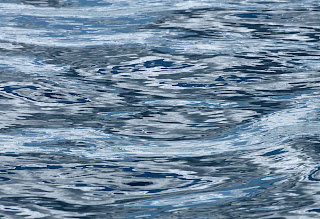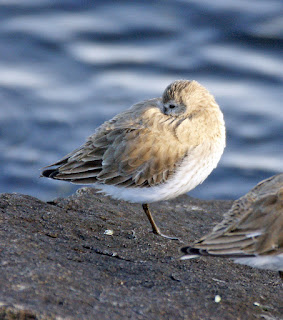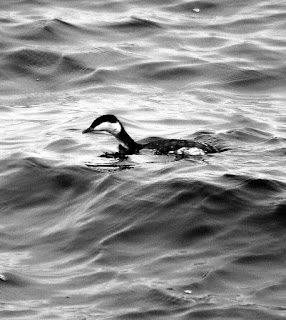Welcome to the Vinalhaven Sightings Report – June 18, 2023
Brought to you by VLT and MCHT! Thanks!
Youngster edition part 1
Thank you Claudia Dengler for sharing the photos and info!
Business – Contact us – vinalhavensightings@gmail.com
Tiit trick –
Click on the photos and they get large, click again and they are back to ‘normal’.
Sorry – there is no middle ground/medium sized.
Question – Have
you ever seen or heard of anyone seeing Weasels on island? Not Mink, not River
Otters, but Weasels - white in the winter, brown and white in the summer, tip
of the tail black? Please share if you
have!

weasel kit!
photo by Claudia Dengler
Here’s how we understand it - Claudia Dengler, up Crocketts Cove way,
reported seeing an adult weasel with a brown
back and white belly at her place in early May (?). That would make it a Short-tailed (Ermine) or Long-tailed Weasel,
and telling the difference from a quick glance can be tricky. As far as nature
sightings go – this was extremely exciting. I mean, anytime you see a member of
the Mustelidae (Weasel family) it’s exciting. Be it a Mink, an Otter, a weasel,
etc.

weasel kit in action!
photo by Claudia Dengler
For years I’ve nonchalantly tossed
around the phrase ‘Vinalhaven – where
weasels rule!’ when asked/talking about ‘large’ predators on island. And it
is not a false statement – during my time on island (2004-2015) Mink and River Otter were the ‘big’
mammalian predators on island - toss in Great
Horned Owls and you have all the ‘big’ predators on island. During those
years of working and tracking all over the island with every snowstorm I never
saw any sign of, much less an actual ‘weasel’ species. Beyond that -I never
heard anyone talking of seeing weasels on Vinalhaven, where reports of mink or
otter sightings were/are somewhat regular. It’s hard to imagine a healthy population
of weasel being on island those years and never coming across any sign at all. Stranger things have happened for sure….
So a new arrival to island life, this
weasel? Newish for sure. Well, turns out Claudia’s weasel sighting may have
been a clue to a larger population on island (like at least two individuals)
since Claudia now reports a young weasel
(properly known as a ‘kit’) was found stuck in her chicken coop. Well, not
only reports – she sent in photos! Check that little kit out! and this fantastic video!
Hard to identify to species via young, but because of info below (there is more to this
story – more at the end of this VSR) lets go with it/them being Short-tailed
Weasels, also known as Ermine, also known as Stoat.
Here’s a little important/pertinent
natural history for ya – Thank Wiki!
‘...territoriality has a generally mustelid spacing pattern, with male
territories encompassing smaller female territories, which they defend from
other males…
The stoat does not dig its own burrows, instead using the burrows and
nest chambers of the rodents it kills. The skins and under fur
of rodent prey are used to line the nest chamber. The nest chamber is
sometimes located in seemingly unsuitable places, such as among logs piled
against the walls of houses. The stoat also inhabits old and rotting stumps,
under tree roots, in heaps of brushwood, haystacks, in bog hummocks, in the cracks of vacant mud buildings, in rock piles, rock
clefts, and even in magpie nests.
Female stoats are usually only in heat for a brief period, which is
triggered by changes in day length…
…Copulation can last as long as 1 hour…
Stoats are not monogamous, with litters often being of mixed paternity.
Stoats undergo embryonic diapause, meaning that the embryo does not immediately
implant in the uterus after fertilization, but rather lies dormant for a period
of nine to ten months. The gestation period is therefore variable but typically
around 300 days, and after mating in the summer, the offspring will not be born
until the following spring – adult female stoats spend almost all their lives
either pregnant or in heat.
Females can reabsorb embryos and in the event of a severe winter they may
reabsorb their entire litter.
Males play no part in rearing the
young, which are born blind, deaf, toothless and covered in fine white or
pinkish down. The milk teeth erupt after three weeks, and solid food is eaten
after four weeks. The eyes open after five to six weeks, with the black
tail-tip appearing a week later. Lactation ends after 12 weeks. Prior to the
age of five to seven weeks, kits have poor thermoregulation, so they huddle for
warmth when the mother is absent.
Males become sexually mature at 10–11 months, while females are sexually
mature at the age of 2–3 weeks whilst still blind, deaf and hairless, and are
usually mated with adult males before being weaned.’ – Wiki
Whoa – lots to process there/here.
But since Claudia saw a youngster let’s think about this.
Delayed implantation is a favorite reproduction strategy – usually on everyone’s ‘top 5 reproductive strategy list’ for
sure. Saying the female has a 300 day gestation period is not totally correct
Wiki, since for 9-10 months there is no development – gestation means
development! Semantics, but while the egg is fertilized for a long time, it’s
only attached to the uterus for a month, month and a half. Anyway – we are big
fans of delayed implantation or embryonic diapause.
Anyway, the fact of the matter is –
there is a female weasel out on island
that was pregnant, gave birth around
March/April – April births are nice, especially on the Taurus sides of
things…. – and now the youngsters are getting out on their own. Whoa.
And you may ask yourself – well, how did I get here?
Beyond the thought of someone
purposefully bringing and releasing Weasels on Vinalhaven…
Island hopping?
– A weasel swimming across Penobscot Bay from Rockland seems unlikely (though
understandable) – these are animals with high metabolism that aren’t
necessarily built for swimming (these ain’t otters or mink). So then we toss out maybe coming down from
Isleboro or Stonington or Merchant Row from the north. Still seems like a long
way for a Weasel – but you know – survival in nature gets beyond the scope of
simple human minds like mine.
The Weasel island hopping idea would
likely have taken any of them through North Haven, so I reached out to some
North Haven sources and asked – albeit to only a few folks - about the presence
of Weasels on that island and the word I got back was – no. Or at least they
are not reported/talked about. Weasels only on Vinalhaven? Understandable.
Ferry ride? –
So the next logical way a wild weasel would get to Vinalhaven would get to Vinalhaven would be by the ferry/boat. John Drury and I actually talked about this in the winter (more below on this), about a weasel being on a truck and brought out to the island but we couldn’t wrap our heads around why a weasel on a lumber truck wouldn’t get off the truck when it started moving. Maybe a weasel stuck in a transfer station container? Could be – something that it couldn’t get out of until it was opened from the outside and let’s just say - I wouldn’t want to be the guy opening that container! Freaked out weasel anyone?
Well, it has now been reported that
years ago – like years ago – a weasel was observed on a bait truck that was
sitting in the ferry line in Rockland. Ahhhhh, a container truck with food on
it! Now that makes sense, or at least more/some sense. Go for a ride, eat some
fish.
In no way are we saying this
observation from back in the day is how this particular weasel got out to
Vinalhaven, but it does add a visual to the options. A weasel visible on a bait
truck in Rockland might be more likely to bail before the truck gets onto the
ferry, but still – it’s a route to the island. A weasel in a bait container,
blissed out on fish, could get out undetected. Speculator going full throttle
and clearly I don’t know how bait containers work. There are lots of bigger
boats – island transporter, etc. - that come and go as well.
Probably not by plane
Seal Bay –
Now here’s the interesting stuff to
me. Unless folks have been seeing weasels and keeping that info to themselves
(come on! Share!) This is likely a recent arrival. I am out on island a lot in
winter, but not after every snow and my zones are pretty limited – there could
be a gagillion weasels at Perry Creek and I would never see ‘em or their sign since
I never track there! This winter
however, I was scouting for potential trail options on Seal Bay when I came
across a small bounding trail in the snow. This was back in February and it
totally blew me away. I mean – tracking on Vinalhaven is nice and fairly simple
with few choices. From all those years of tracking on island recognizing Mink
or Otter tracks/trails is easy, and these tracks were clearly small. I toyed
with maybe a bounding short-tailed shrew – which would have been a new species
for me on Vinalhaven – but eventually decided on ‘pygmy mink’, maybe a case of ‘island
biogeography shrinkage’. I am joking of course, I figured it was a weasel but wasn’t
about to let a weasel out of the bag without more proof.
At the same time I had forgotten
about a game camera I had placed nearby in the hopes of getting otter footage.
Turns out I got lots of raccoon and mink clips, and this brief crappy video clip of a
weasel in its winter coat! Its a 15 second clip- but really its the first three seconds that count. The weasel triggered the camera mid run and then continued on. pause the video and go in slow motion
here's a zoomed in version
 |
| weasel track on left mink bounding trail down the middle for comparison |
It was a quick cameo, but comparing
it with another clip of a red squirrel (nemesis!) showed that the weasel was
roughly the same size – maybe a little bigger. I continued to track in the
area, and put up cameras in hopes of getting more/better clips of the weasel
but poof – it was gone like Keyser Soze. Maybe made a run to Crockett Cove?
Back to the wiki stuff –
So the whole delayed implantation
thing comes into play here potentially. Is there a population of weasel in
island? Or did a ‘pregnant’ female get onto the island with floating fertilized
eggs and has now given birth? And the whole ‘litters often being of mixed paternity’ thing – could a pregnant
female with 5-12 unattached eggs that were fertilized by multiple males start a
population? I mean, sure the kits would share half their genes (or all of them)
so the inbreeding potential is high, but is there a chance? I don’t know – it’s
still a bottleneck. Speculator going full throttle.
Trying not to anthropomorphosize –
So – if you read the info in bold way towards
the beginning of this you may have noted that female weasels become ‘sexually mature at 2-3 weeks … and are
usually mated with adult males before being weaned’. Wow. Sounds young,
almost a little too young – but who are we to judge. Weasels live a fast paced
lifestyle – one that averages about 2
years in length in the wild. Meaning a female may only have one shot at
reproducing if she waits a year until mating. So as a species, weasels have apparently
evolved a reproductive strategy that includes adult males mating with females
younger than 12 weeks, at which point kits are weaned. Still sounds shocking,
but that is probably human nature on my part.
It’s fun to learn about animal
strategies, but like the Girl Scout leader said to me after I led her group to
see Elephant Seals, which just happened to be very active when we saw them. She
said ‘I’m just glad I’m not a female Elephant Seal’. I’m glad I am not a
weasel, but I have been called worse!
Anyway – so we’ll wait and see what
pans out with the weasel scene on Vinalhaven. There sure are plenty of rodents
around, and reports and sightings to be had and shared. If you have any info
that can help fill in the blanks of our island weasel understanding please do
share.
And the biggest thanks possible to
Claudia for sharing the photos and video of the kit she found.
 |
| track mom |
Until then – I’ll see you out there!
.jpg)



.jpg)












































